Creating Comparability among European Neighbourhoods to Enable the Transition of District Energy Infrastructures towards Positive Energy Districts
Abstract
:1. Introduction
2. Theoretical Background
3. Methodology
- (a)
- A district or neighbourhood geographical scale (or any cluster of buildings);
- (b)
- A time resolution from hourly to seasonal;
- (c)
- An infrastructure that was within the scope of this work, i.e., renewable energy generation technology, energy storage and EV charging technology, heating and cooling systems and building envelopes;
- (d)
- Aims that are relevant for energy planning (i.e., not frequency regulation or power sector specifics).
4. Model Details
4.1. Input Parameters for District Categorisation
5. Visualisation of Results
6. Conclusions
Author Contributions
Funding
Institutional Review Board Statement
Informed Consent Statement
Data Availability Statement
Conflicts of Interest
Abbreviations
| DCM | District Categorisation Matrix |
| DH | District Heating |
| EV | Electric Vehicle |
| Floor Space Index | |
| HVAC | Heating, Ventilation and Air Conditioning |
| KPI | Key Performance Indicator |
| PED | Positive Energy District |
| PV | Photovoltaic Panel |
Appendix A
| Model | Aim/Output | Requirement/Input | Method | Time Resolution | Spatial Aspect | Sectors |
|---|---|---|---|---|---|---|
| Calliope [44,45,46] | Energy portfolio and dispatch optimisation | Demand profiles, technology to consider, available area, meteorological data and costs | Bottom-up; MILP | User defined | User defined | Electricity, heating and mobility (limited) |
| City-BES [47] | User defined, e.g., energy-, emissions- and cost-related KPIs for each retrofit scenario | The footprint, type, height, year of construction and number of stories of the buildings, shading buildings, shared walls and weather | Bottom-up; physics-based (based on EnergyPlus) | Sub-hourly | Cities | Electricity and heating |
| City Energy Analyst [48] | Building energy consumption patterns in neighbourhoods and districts | Weather data, urban GIS data building archetypes, distributions database (occupancy schedules; 16 types in this case) and measurements database (for non-standardised energy services in the area, e.g., stadia) | Bottom-up (two methods of load calculation: analytical and statistical) | Hourly | Neighbourhoods | Electricity and heating |
| CitySim [49] | Heating and cooling demands and urban planning | Building characteristics and climate files | Dynamic building energy simulation; reduced-order RC model | 1 min–1 h | Streets to districts | Electricity and heating |
| DER-CAM [50] | Energy portfolio and dispatch optimisation | Demand profiles, technology to consider, available area, meteorological data and costs | Bottom-up; MILP | User defined (reference: days) | Buildings to microgrids (districts) | Electricity, heating and mobility (limited) |
| DIMOSIM [51] | Raw outputs, i.e., states of each object (e.g., temperature) and energy fluxes (e.g., consumption per fuel) and KPIs generated from the raw outputs that related to thermal indoor comfort, energy, power and costs | Climatic characteristics, building geometry, U-values and surface ratios of the different components within the envelope, HVAC system characteristics, occupancy rates, insulation types (e.g., indoor or outdoor) and inertia level | Bottom-up; simulation; possible optimisation | User defined (range of minutes to hours) | Small neighbourhoods to cities | Electricity and heating |
| EnergyPlan [52] | Operation of energy systems and environmental and economic impacts | Installed capacity, available energy and energy demands | Bottom-up; simulation (based on heuristic technique) | Hourly | Cities to countries | Electricity and heating |
| EnergyPlus [53] | Dynamic building simulations and HVAC | Climate data, U- and g-values, heating and cooling systems, temperature set-point (min; max), air change per hour, internal heat gain, external short-wave absorbance and long-wave emissivity | Bottom-up; physics-based | User defined | Buildings | Electricity and heating |
| ESP-r [54] | Dynamic building simulations and HVAC | Climate data, U- and g-values, heating and cooling systems, temperature set-point (min; max), air change per hour, internal heat gain, external short-wave absorbance and long-wave emissivity | Bottom-up; physics-based | User defined | Buildings to districts | Electricity and heating |
| Homer [55] | Energy portfolio and dispatch optimisation | Demand profiles, technology to consider, available area, meteorological data and costs | Bottom-up | User defined | Microgrids (districts) | Electricity, heating and mobility (limited) |
| oemof [56] | Multiple Python libraries for optimisation and modelling of energy systems | Demand profiles, technology to consider, available area, meteorological data and costs | Bottom-up | User defined (reference: days) | Buildings to microgrids (districts) | Electricity, heating and mobility (limited) |
| Smart-E [57] | Energy demand simulation, implementation of demand–response strategies in cities | Weather data, household composition, envelope characteristics, heating energy demands, location, time of use (schedule) and probabilities (household equipment, set points, etc.) | Bottom-up; simulation | Daily | Cities to larger territories | Electricity and heating |
| TRNSYS [58] | Thermal and electrical energy systems, dynamic systems, traffic flow and biological processes | User defined components and library components | Simulation; linear and nonlinear programming | 0.01 s–1 h | Buildings to districts | Electricity, heating and mobility |
| urbs [59] | Energy portfolio and dispatch optimisation | Demand profiles, technology to consider, available area, renewable energy supplies as time series and costs | Bottom-up | User defined | User defined | Electricity, heating and mobility (limited) |
| UMI [60] | Walkability, environmental performance and daylight potential | Parks, streets, shadings, boundaries, ground and the geometry, occupancy and fenestration of buildings | Simulation (based on EnergyPlus, rhinoceros and Daysim) | … | Streets to districts | Electricity, heating and mobility |
Appendix B
- Total gross floor area;
- Residential gross floor area;
- Final heat demand density.
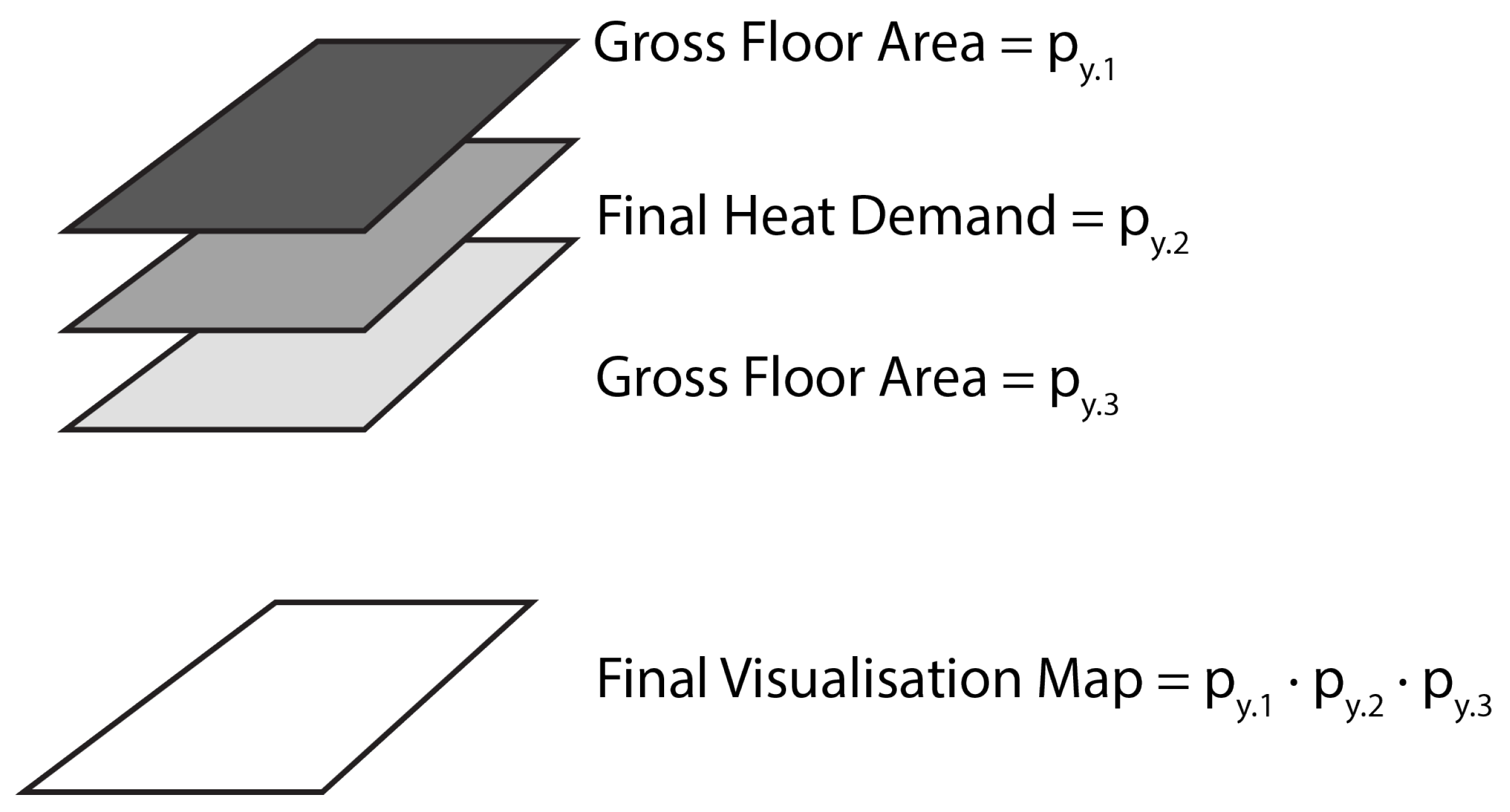
| Thresholds | Letter Indicator | Prime Number Indicator | |
|---|---|---|---|
| Final Heat Demand Density | 417 | A | 2 |
| 417–1417 | B | 3 | |
| 1417–2961 | C | 5 | |
| 2961 | D | 7 | |
| Total Gross Floor Area | 0.25 | A | 9 |
| 0.25–1 | B | 11 | |
| 1–2 | C | 13 | |
| 2 | D | 17 | |
| Percentage of Residential GFA | 0.25 | A | 23 |
| 0.25–0.5 | B | 27 | |
| 0.5–0.75 | C | 29 | |
| 0.75 | D | 31 |
References
- United Nations Human Settlements Programme. Unpacking the Value of Sustainable Urbanization; World Cities Report 2020; UN: Nairobi, Kenya, 2020; pp. 43–74. [Google Scholar] [CrossRef]
- JPI Urban Europe. White Paper on PED Reference Framework for Positive Energy Districts and Neighbourhoods. 2020. Available online: https://jpi-urbaneurope.eu/wp-content/uploads/2020/04/White-Paper-PED-Framework-Definition-2020323-final.pdf (accessed on 21 June 2022).
- MAKING CITY. Making City—Energy Efficient Pathway for the City Transformation. Available online: https://makingcity.eu/ (accessed on 2 March 2022).
- +CityxChange. Available online: https://cityxchange.eu/ (accessed on 2 March 2022).
- IEA EBC. Annex 83-Positive Energy Districts. Available online: https://annex83.iea-ebc.org/ (accessed on 2 March 2022).
- POCITYF. Leading the Smart Evolution of Historical Cities. Available online: https://pocityf.eu/ (accessed on 2 March 2022).
- Bruck, A.; Díaz Ruano, S.; Auer, H. A Critical Perspective on Positive Energy Districts in Climatically Favoured Regions: An Open-Source Modelling Approach Disclosing Implications and Possibilities. Energies 2021, 14, 4864. [Google Scholar] [CrossRef]
- Bossi, S.; Gollner, C.; Theierling, S. Towards 100 positive energy districts in Europe: Preliminary data analysis of 61 European cases. Energies 2020, 13, 6083. [Google Scholar] [CrossRef]
- Alpagut, B.; Lopez Romo, A.; Hernández, P.; Tabanoğlu, O.; Hermoso Martinez, N. A GIS-Based Multicriteria Assessment for Identification of Positive Energy Districts Boundary in Cities. Energies 2021, 14, 7517. [Google Scholar] [CrossRef]
- JPI Urban Europe. Europe towards Positive Energy Districts; PED Booklet 2020; 180p, Available online: https://jpi-urbaneurope.eu/wp-content/uploads/2020/06/PED-Booklet-Update-Feb-2020_2.pdf (accessed on 21 June 2022).
- Zwickl-Bernhard, S.; Auer, H. Open-source modeling of a low-carbon urban neighborhood with high shares of local renewable generation. Appl. Energy 2021, 282, 116166. [Google Scholar] [CrossRef]
- Fulmer, J.E. What is the World Infrastructure? PEI Infrastruct. Investor 2009, 1, 30–32. [Google Scholar]
- Brozovsky, J.; Gustavsen, A.; Gaitani, N. Zero emission neighbourhoods and positive energy districts—A state-of-the-art review. Sustain. Cities Soc. 2021, 72, 103013. [Google Scholar] [CrossRef]
- Chang, M.; Thellufsen, J.Z.; Zakeri, B.; Pickering, B.; Pfenninger, S.; Lund, H.; Østergaard, P.A. Trends in tools and approaches for modelling the energy transition. Appl. Energy 2021, 290, 116731. [Google Scholar] [CrossRef]
- Siedentop, S.; Schiller, G.; Koziol, M.; Walther, J.; Gutsche, J.M. Siedlungsentwicklung und Infrastrukturfolgekosten—Bilanzierung und Strategieentwicklung; Technical Report 3; Bundesamt für Bauwesen und Raumordnung: Bonn, Germany, 2006. [Google Scholar]
- Nzengue, Y.; du Boishamon, A.; Laffont-Eloire, K.; Partenay, V.; Abdelouadoud, Y.; Zambelli, P.; D’Alonzo, V.; Vaccaro, R. Planning city refurbishment: An exploratory study at district scale how to move towards positive energy districts—Approach of the SINFONIA project. In Proceedings of the 2017 International Conference on Engineering, Technology and Innovation (ICE/ITMC), Madeira, Portugal, 27–29 June 2017; pp. 1394–1400. [Google Scholar] [CrossRef]
- Hachem-Vermette, C.; Singh, K. Optimization of energy resources in various building cluster archetypes. Renew. Sustain. Energy Rev. 2022, 157, 112050. [Google Scholar] [CrossRef]
- Hachem-Vermette, C.; Singh, K. Energy Systems and Energy Sharing in Traditional and Sustainable Archetypes of Urban Developments. Sustainability 2022, 14, 1356. [Google Scholar] [CrossRef]
- Pezzutto, S.; Croce, S.; Zambotti, S.; Kranzl, L.; Novelli, A.; Zambelli, P. Assessment of the space heating and domestic hot water market in Europe—Open data and results. Energies 2019, 12, 1760. [Google Scholar] [CrossRef] [Green Version]
- Hotmaps Project. Library-Hotmaps Project. Available online: https://www.hotmaps-project.eu/library/ (accessed on 21 June 2022).
- Müller, A.; Hummel, M.; Kranzl, L.; Fallahnejad, M.; Büchele, R. Open Source Data for Gross Floor Area and Heat Demand Density on the Hectare Level for EU 28. Energies 2019, 12, 4789. [Google Scholar] [CrossRef] [Green Version]
- Markovic, D.; Cvetkovic, D.; Masic, B. Survey of software tools for energy efficiency in a community. Renew. Sustain. Energy Rev. 2011, 15, 4897–4903. [Google Scholar] [CrossRef]
- Keirstead, J.; Jennings, M.; Sivakumar, A. A review of urban energy system models: Approaches, challenges and opportunities. Renew. Sustain. Energy Rev. 2012, 16, 3847–3866. [Google Scholar] [CrossRef] [Green Version]
- Allegrini, J.; Orehounig, K.; Mavromatidis, G.; Ruesch, F.; Dorer, V.; Evins, R. A review of modelling approaches and tools for the simulation of district-scale energy systems. Renew. Sustain. Energy Rev. 2015, 52, 1391–1404. [Google Scholar] [CrossRef]
- Huang, Z.; Yu, H.; Peng, Z.; Zhao, M. Methods and tools for community energy planning: A review. Renew. Sustain. Energy Rev. 2015, 42, 1335–1348. [Google Scholar] [CrossRef]
- Ferrari, S.; Zagarella, F.; Caputo, P.; Bonomolo, M. Assessment of tools for urban energy planning. Energy 2019, 176, 544–551. [Google Scholar] [CrossRef]
- Abbasabadi, N.; Mehdi Ashayeri, J.K. Urban energy use modeling methods and tools: A review and an outlook. Build. Environ. 2019, 161, 106270. [Google Scholar] [CrossRef]
- Klemm, C.; Vennemann, P. Modeling and optimization of multi-energy systems in mixed-use districts: A review of existing methods and approaches. Renew. Sustain. Energy Rev. 2021, 135, 110206. [Google Scholar] [CrossRef]
- Yazdanie, M.; Orehounig, K. Advancing urban energy system planning and modeling approaches: Gaps and solutions in perspective. Renew. Sustain. Energy Rev. 2021, 137, 110607. [Google Scholar] [CrossRef]
- Bouw, K.; Noorman, K.J.; Wiekens, C.J.; Faaij, A. Local energy planning in the built environment: An analysis of model characteristics. Renew. Sustain. Energy Rev. 2021, 144, 111030. [Google Scholar] [CrossRef]
- Kottek, M.; Grieser, J.; Beck, C.; Rudolf, B.; Rubel, F. World Map of the Köppen-Geiger climate classification updated. Meteorol. Z. 2006, 15, 259–263. [Google Scholar] [CrossRef]
- Beck, H.E.; Zimmermann, N.E.; McVicar, T.R.; Vergopolan, N.; Berg, A.; Wood, E.F. Present and future Köppen-Geiger climate classification maps at 1-km resolution. Sci. Data 2018, 5, 1–12. [Google Scholar] [CrossRef] [Green Version]
- Ascencio-Vásquez, J.; Brecl, K.; Topič, M. Methodology of Köppen-Geiger-Photovoltaic climate classification and implications to worldwide mapping of PV system performance. Solar Energy 2019, 191, 672–685. [Google Scholar] [CrossRef]
- PVSITES Consortium. D2.2 European Climate Zones and Bio-Climatic Design Requirements. Technical Report. 2016. Available online: https://ec.europa.eu/research/participants/documents/downloadPublic?documentIds=080166e5ac7b5027&appId=PPGMS (accessed on 21 June 2022).
- Leibold, J.; Schneider, S.; Tabakovic, M.; Zelger, T.; Bell, D.; Schöfmann, P.; Bartlmä, N. ‘Zukunftsquartier’—On the Path to Plus Energy Neighbourhoods in Vienna. In Sustainability in Energy and Buildings; Springer: Singapore, 2020; pp. 199–209. [Google Scholar] [CrossRef]
- Caves, R.W. Encyclopedia of the City; Routledge: Abingdon, UK, 2005. [Google Scholar]
- Hachem-Vermette, C.; Singh, K. Optimization of the mixture of building types in a neighborhood and their energy and environmental performance. Energy Build. 2019, 204, 109499. [Google Scholar] [CrossRef]
- Yuan, J.; Zhang, G.; Yu, S.S.; Chen, Z.; Li, Z.; Zhang, Y. A multi-timescale smart grid energy management system based on adaptive dynamic programming and Multi-NN Fusion prediction method. Knowl. Based Syst. 2022, 241, 108284. [Google Scholar] [CrossRef]
- Smart-BEEjS. Innovative Training Network—Smart Value Generation by Building Efficiency and Energy Justice for Sustainable Living. Available online: https://smart-beejs.eu/ (accessed on 21 June 2022).
- ATELIER. ATELIER-Positive Energy Districts. Available online: https://smartcity-atelier.eu/ (accessed on 21 June 2022).
- Stadt Frankfurt am Main. Frankfurt a.M. Griesheim-Mitte—Integriertes Städtebauliches Entwicklungskonzept; Technical Report; Stadtplanungsamt Frankfurt am Main: Frankfurt, Germany, 2019. [Google Scholar]
- Google Maps. Griesheim-Mitte—Google Maps. Available online: https://www.google.com/maps/place/Griesheim,+Frankfurt,+Germany/@50.0983916,8.5985339,15.3z/data=!4m5!3m4!1s0x47bd0a2fd4be4e49:0x522435029b39a00!8m2!3d50.0965406!4d8.5987565 (accessed on 21 June 2022).
- Google Maps. Buiksloterham-South—Google Maps. Available online: https://www.google.com/maps/place/Buiksloterham,+Amsterdam,+Netherlands/@52.3901559,4.8951995,15.56z/data=!4m5!3m4!1s0x47c6083a59bcc9b5:0x5b0aa59876a0ead1!8m2!3d52.401543!4d4.8907417 (accessed on 21 June 2022).
- Pfenninger, S.; Pickering, B. Calliope: A multi-scale energy systems modelling framework. J. Open Source Softw. 2018, 3, 825. [Google Scholar] [CrossRef] [Green Version]
- Calliope: A multi-Scale Energy Systems Modelling Framework—Calliope 0.6.7 Documentation. Available online: https://calliope.readthedocs.io/en/stable/ (accessed on 15 December 2021).
- Luz, G.P.; E Silva, R.A. Modeling Energy Communities with Collective Photovoltaic Self-Consumption: Synergies between a Small City and a Winery in Portugal. Energies 2021, 14, 323. [Google Scholar] [CrossRef]
- Chen, Y.; Hong, T.; Piette, M.A. Automatic generation and simulation of urban building energy models based on city datasets for city-scale building retrofit analysis. Appl. Energy 2017, 205, 323–335. [Google Scholar] [CrossRef] [Green Version]
- Fonseca, J.A.; Nguyen, T.A.; Schlueter, A.; Marechal, F. City Energy Analyst (CEA): Integrated framework for analysis and optimization of building energy systems in neighborhoods and city districts. Energy Build. 2016, 113, 202–226. [Google Scholar] [CrossRef]
- Walter, E.; Kämpf, J.H. A Verification of CitySim Results Using the BESTEST and Monitored Consumption Values; Bozen-Bolzano University Press: Bozen-Bolzano, Italy, 2015; pp. 215–222. [Google Scholar]
- DER-CAM|Grid Integration Group. Available online: https://gridintegration.lbl.gov/der-cam (accessed on 15 December 2021).
- Garreau, E.; Abdelouadoud, Y.; Herrera, E.; Keilholz, W.; Kyriakodis, G.E.; Partenay, V.; Riederer, P. District MOdeller and SIMulator (DIMOSIM)—A dynamic simulation platform based on a bottom-up approach for district and territory energetic assessment. Energy Build. 2021, 251, 111354. [Google Scholar] [CrossRef]
- Lund, H.; Thellufsen, J.Z.; Østergaard, P.A.; Sorknæs, P.; Skov, I.R.; Mathiesen, B.V. EnergyPLAN—Advanced analysis of smart energy systems. Smart Energy 2021, 1, 100007. [Google Scholar] [CrossRef]
- Crawley, D.B.; Pedersen, C.O.; Lawrie, L.K.; Winkelmann, F.C. EnergyPlus: Energy Simulation Program. ASHRAE J. 2000, 42, 49–56. [Google Scholar]
- Energy Systems Research Unit, University of Strathclyde. A Tour of ESP-r. Available online: https://www.esru.strath.ac.uk//Courseware/ESP-r/tour/ (accessed on 21 June 2022).
- HOMER—Hybrid Renewable and Distributed Generation System Design Software. Available online: https://www.homerenergy.com/ (accessed on 15 December 2021).
- Hilpert, S.; Kaldemeyer, C.; Krien, U.; Günther, S.; Wingenbach, C.; Plessmann, G. The Open Energy Modelling Framework (oemof)—A new approach to facilitate open science in energy system modelling. Energy Strategy Rev. 2018, 22, 16–25. [Google Scholar] [CrossRef] [Green Version]
- Berthou, T.; Duplessis, B.; Rivière, P.; Stabat, P.; Casetta, D.; Marchio, D. Smart-E: A tool for energy demand simulation and optimization at the city scale. In Proceedings of the 14th Conference of International Building Performance Simulation Association, Hyderabad, India, 7–9 December 2015; pp. 1782–1789. [Google Scholar]
- Klein, S.A. TRNSYS 18: A Transient System Simulation Program; Solar Energy Laboratory, University of Wisconsin: Madison, WI, USA, 2018. [Google Scholar]
- Dorfner, J. Urbs: A Linear Optimisation Model for Distributed Energy Systems 2022. Available online: https://urbs.readthedocs.io/en/latest/ (accessed on 21 June 2022).
- Reinhart, C.F.; Cerezo Davila, C. Urban building energy modeling—A review of a nascent field. Build. Environ. 2016, 97, 196–202. [Google Scholar] [CrossRef] [Green Version]

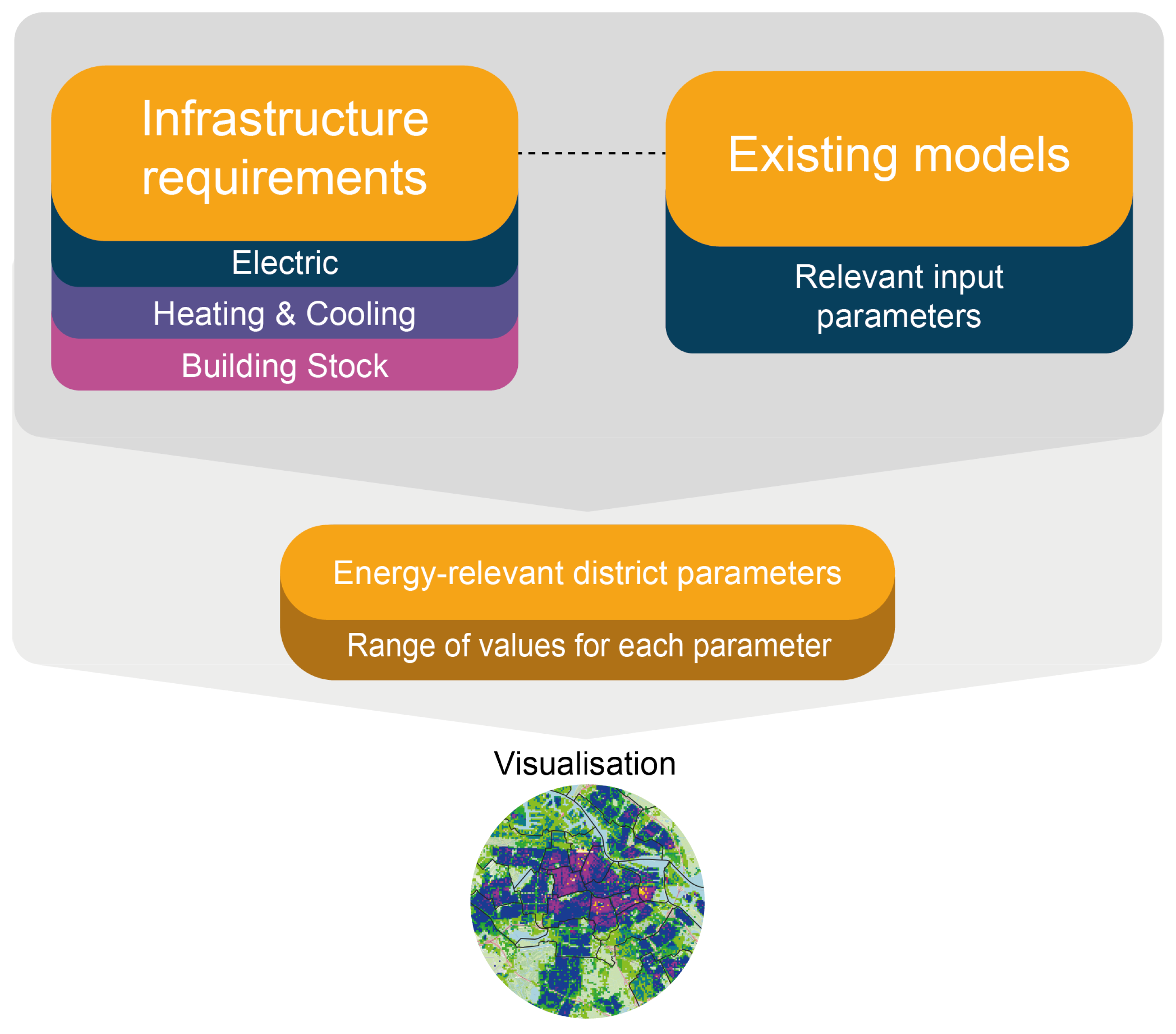
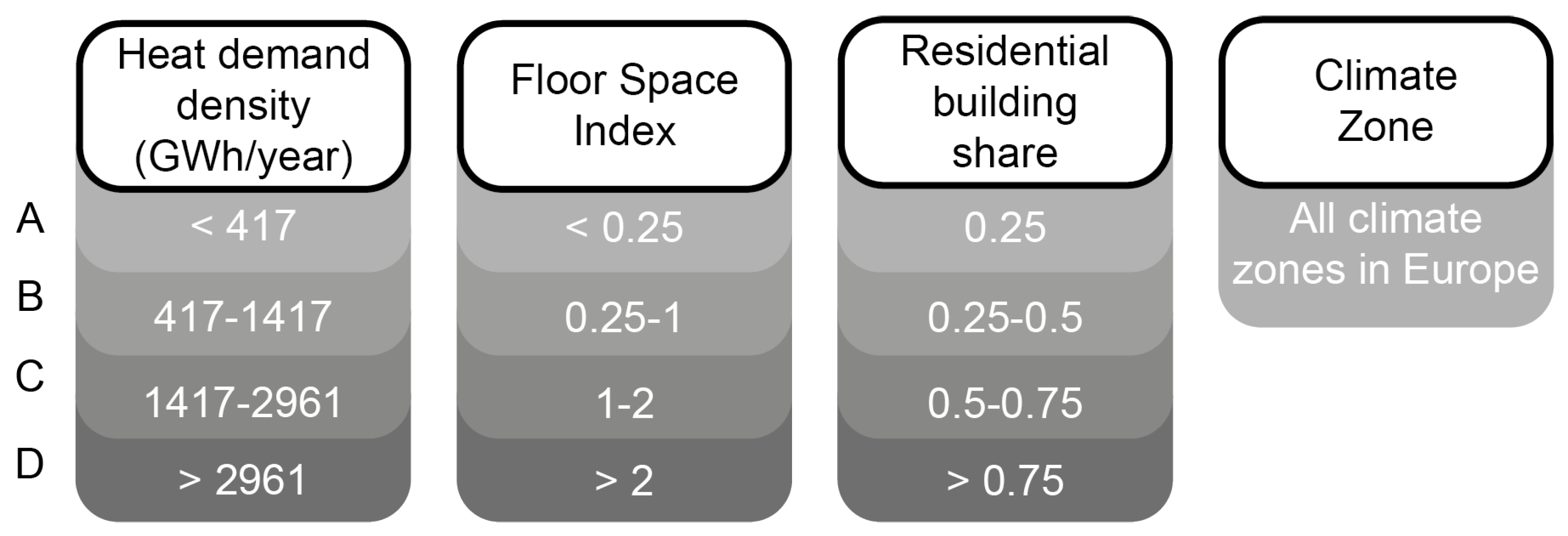
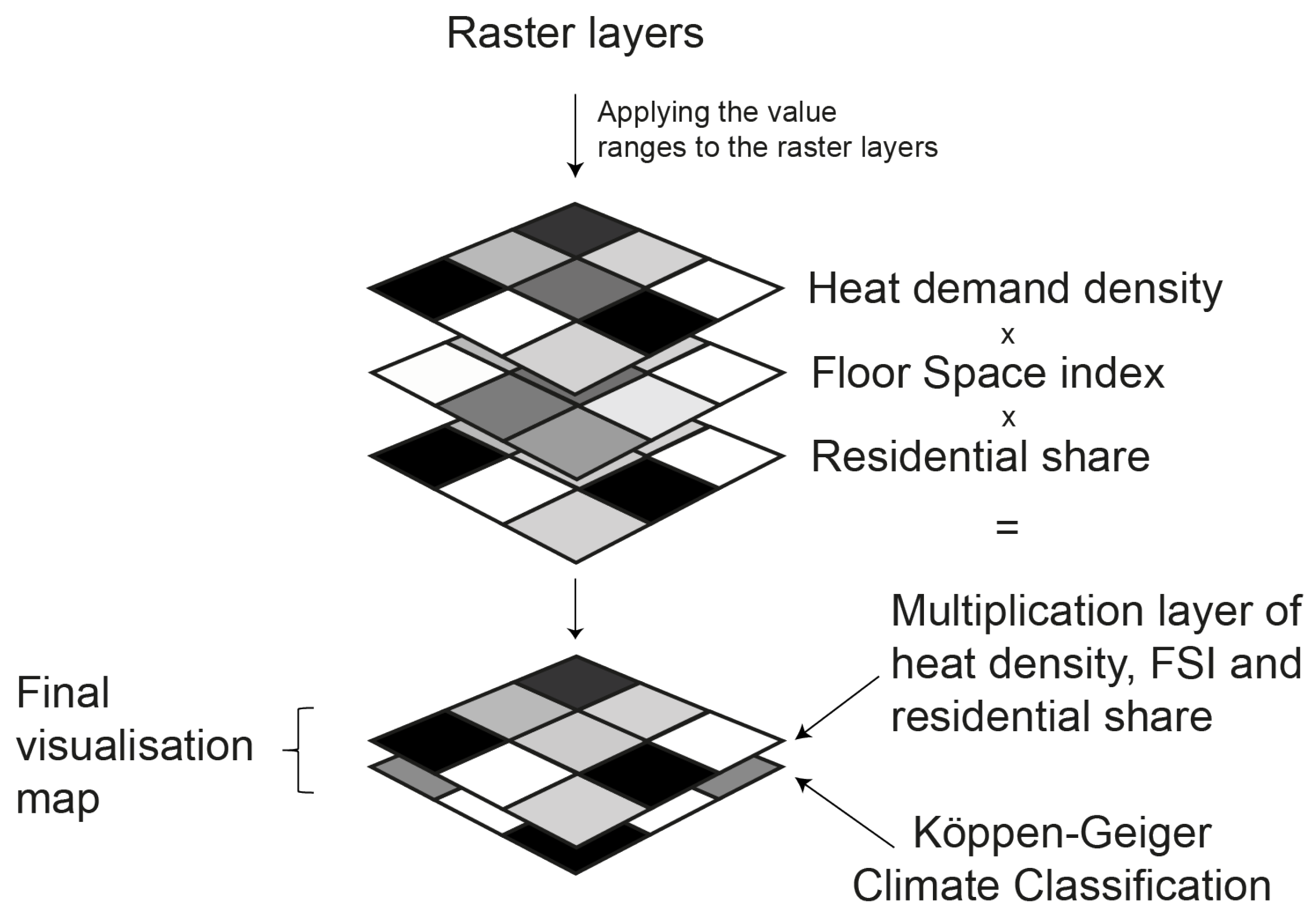
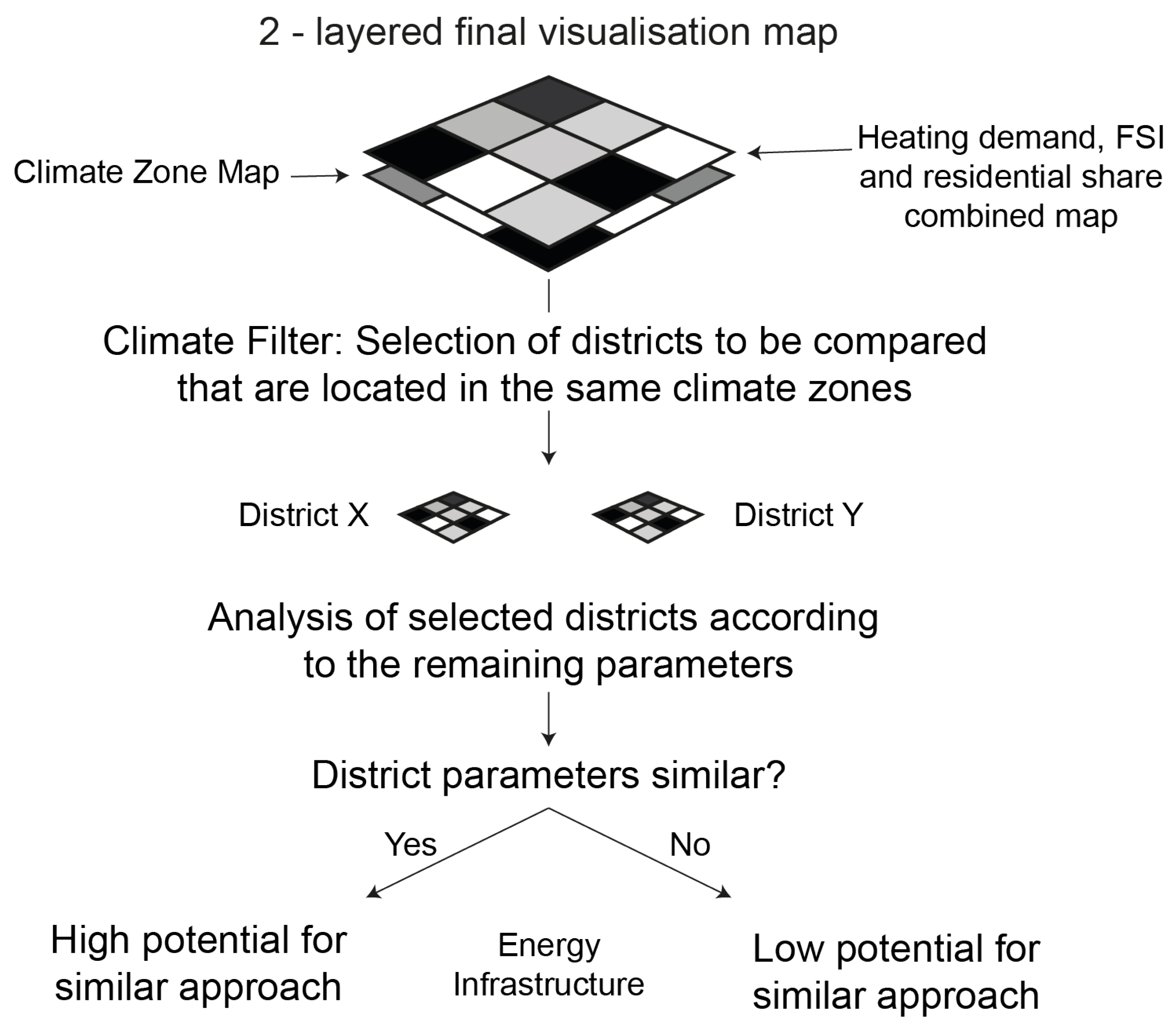
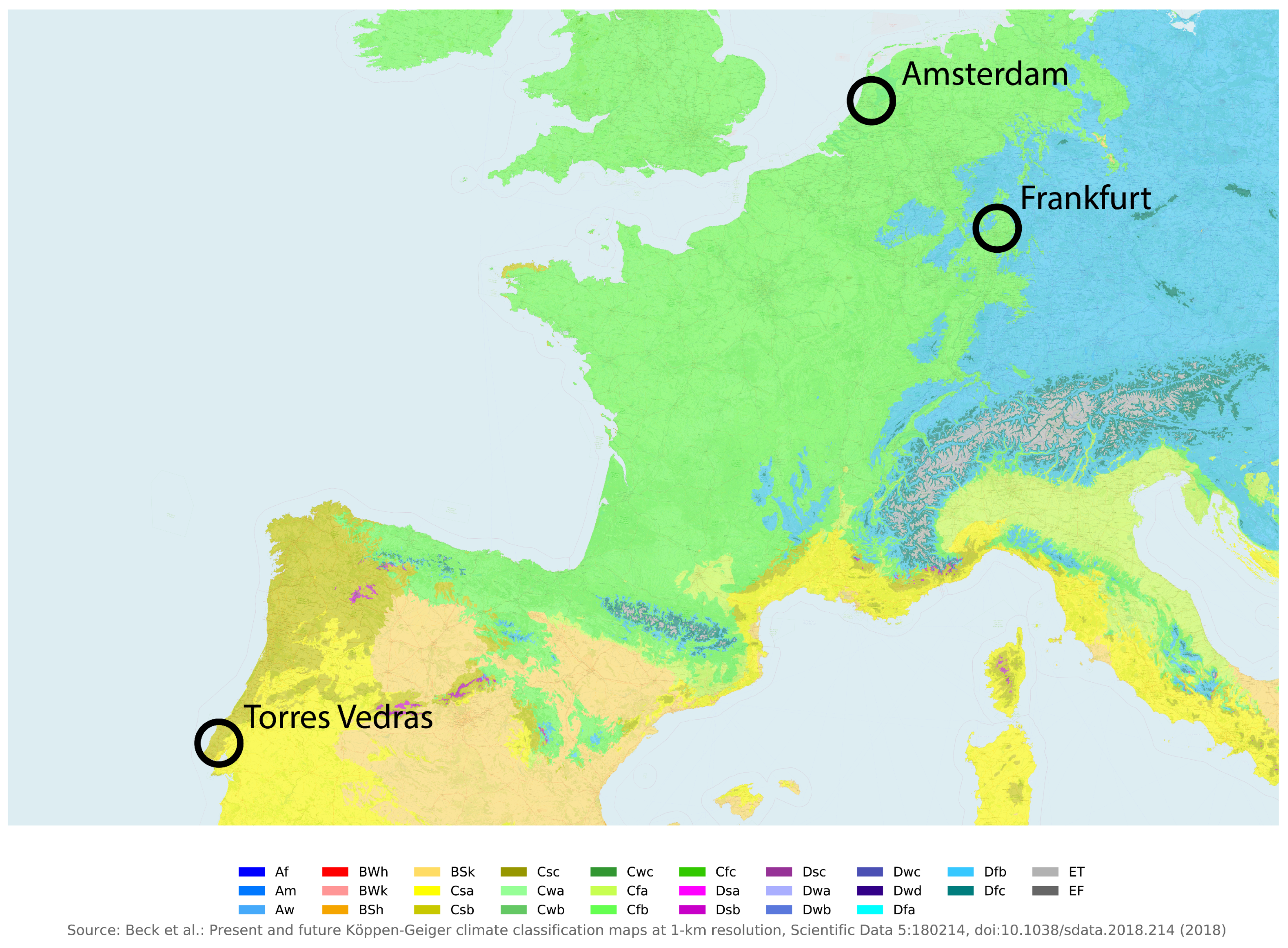

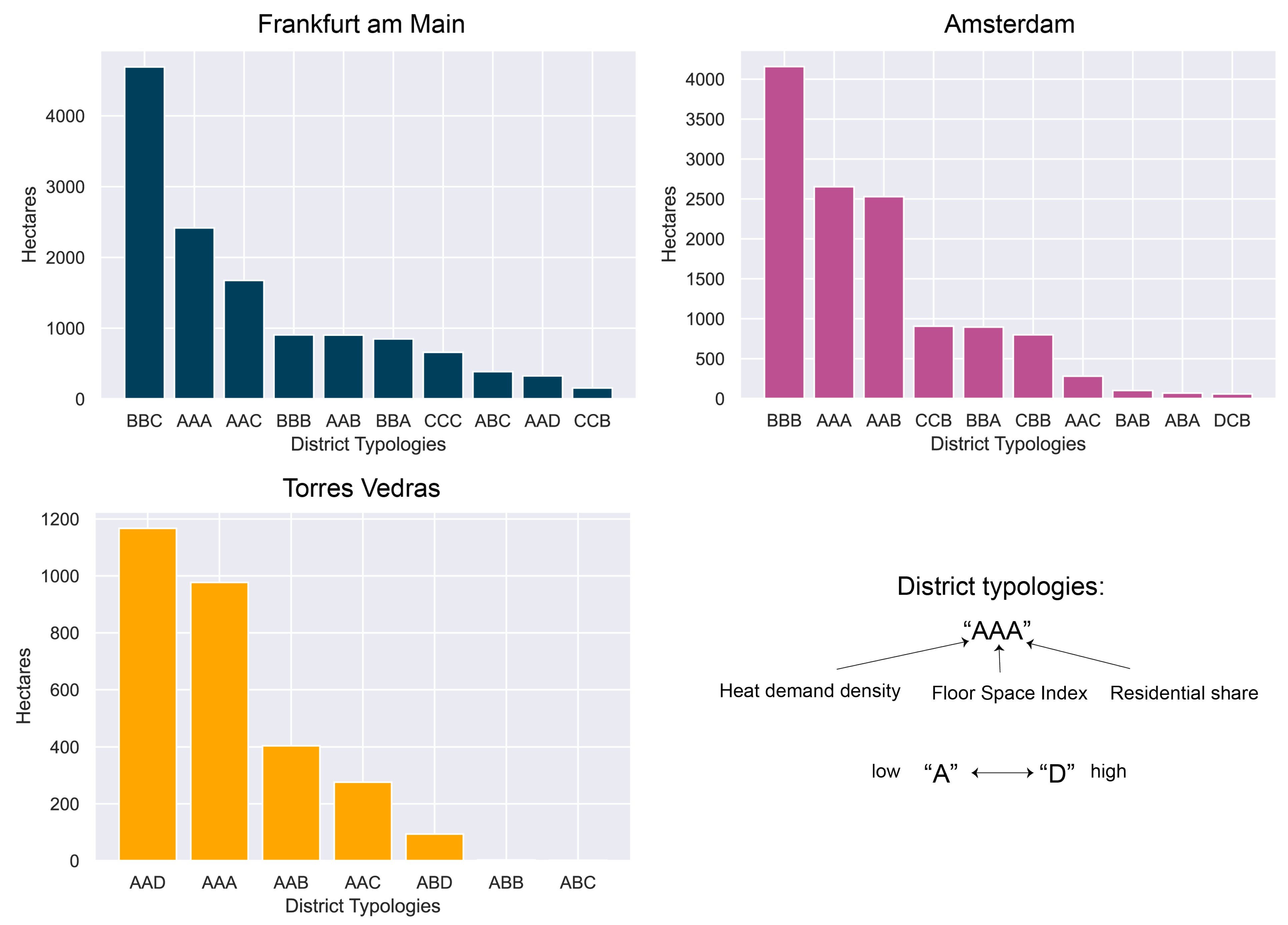



| Matching Data Requirements | Representative Parameters | |
|---|---|---|
| Meteorological data, renewable energy supplies, weather data and climatic characteristics | ⟶ | Climate Zone |
| Demand profiles, building envelopes, U-values, insulation and household equipment | ⟶ | Heating Demand |
| Available area, building type, building height, building archetype and building geometry | ⟶ | Floor Space Index |
| Occupancy behaviour, time of use, net energy demands and PV production | ⟶ | Share of Residential Buildings |
Publisher’s Note: MDPI stays neutral with regard to jurisdictional claims in published maps and institutional affiliations. |
© 2022 by the authors. Licensee MDPI, Basel, Switzerland. This article is an open access article distributed under the terms and conditions of the Creative Commons Attribution (CC BY) license (https://creativecommons.org/licenses/by/4.0/).
Share and Cite
Bruck, A.; Casamassima, L.; Akhatova, A.; Kranzl, L.; Galanakis, K. Creating Comparability among European Neighbourhoods to Enable the Transition of District Energy Infrastructures towards Positive Energy Districts. Energies 2022, 15, 4720. https://doi.org/10.3390/en15134720
Bruck A, Casamassima L, Akhatova A, Kranzl L, Galanakis K. Creating Comparability among European Neighbourhoods to Enable the Transition of District Energy Infrastructures towards Positive Energy Districts. Energies. 2022; 15(13):4720. https://doi.org/10.3390/en15134720
Chicago/Turabian StyleBruck, Axel, Luca Casamassima, Ardak Akhatova, Lukas Kranzl, and Kostas Galanakis. 2022. "Creating Comparability among European Neighbourhoods to Enable the Transition of District Energy Infrastructures towards Positive Energy Districts" Energies 15, no. 13: 4720. https://doi.org/10.3390/en15134720
APA StyleBruck, A., Casamassima, L., Akhatova, A., Kranzl, L., & Galanakis, K. (2022). Creating Comparability among European Neighbourhoods to Enable the Transition of District Energy Infrastructures towards Positive Energy Districts. Energies, 15(13), 4720. https://doi.org/10.3390/en15134720







